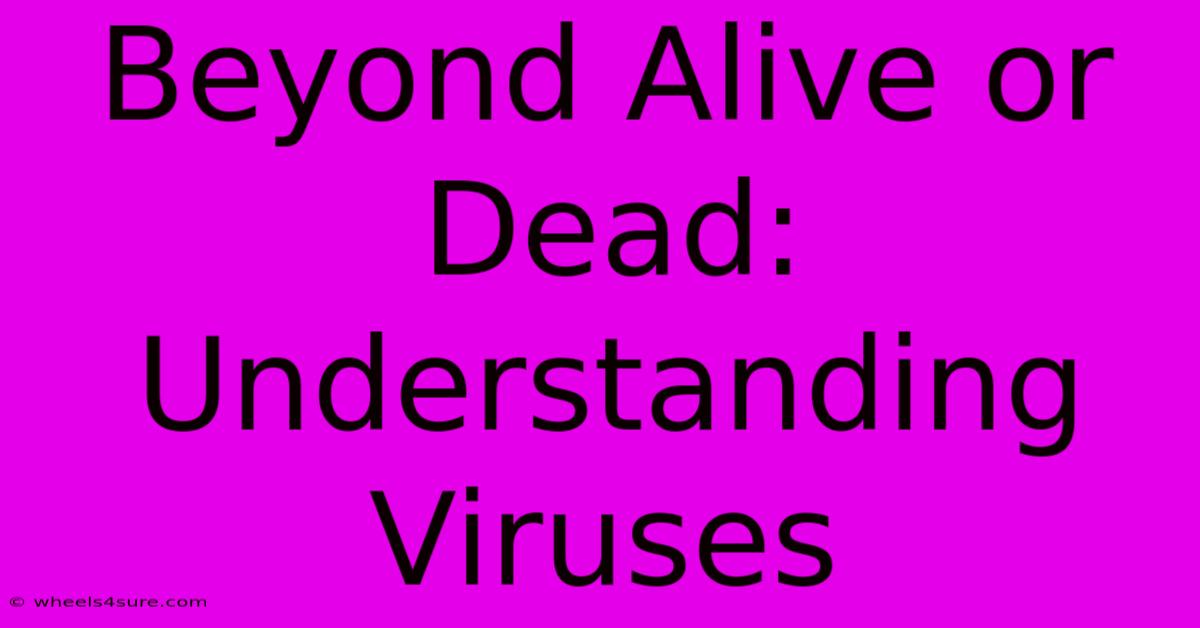Beyond Alive Or Dead: Understanding Viruses

Table of Contents
Beyond Alive or Dead: Understanding Viruses
Viruses. The microscopic entities that cause everything from the common cold to devastating pandemics. But are they truly alive? This question has puzzled scientists for decades. Understanding viruses goes beyond simply classifying them as "alive" or "dead"—it requires exploring their unique characteristics and their complex relationship with the living world.
The Viral Paradox: Alive or Not?
The definition of "life" itself is a complex topic, and viruses don't neatly fit into traditional classifications. They possess some characteristics of living organisms, but lack others. This ambiguity is why they're often described as existing in a gray area, somewhere between life and non-life.
What Viruses Lack:
- Cellular structure: Unlike cells, viruses lack the complex internal machinery necessary for independent metabolism and reproduction. They don't have ribosomes for protein synthesis or the necessary enzymes for energy production.
- Independent metabolism: Viruses cannot generate their own energy or replicate on their own. They are entirely dependent on a host cell to provide the resources for replication.
- Homeostasis: They lack the ability to maintain a stable internal environment.
What Viruses Possess:
- Genetic material: Viruses contain genetic material, either DNA or RNA, that carries the instructions for building more viruses. This genetic material is protected by a protein coat, sometimes with an additional lipid envelope.
- Evolution: Viruses evolve over time, adapting to their host organisms. This adaptation is driven by mutations in their genetic material and natural selection.
- Replication: While dependent on a host, viruses possess the ability to replicate, producing numerous copies of themselves.
The Viral Life Cycle: Hijacking the Host Cell
To understand viruses, it's crucial to understand their life cycle. This process involves several key steps:
1. Attachment:
The virus initially attaches to a specific receptor on the surface of a host cell. This specificity determines which types of cells a virus can infect.
2. Penetration:
The virus then enters the host cell, either by fusing with the cell membrane, being engulfed by the cell, or injecting its genetic material into the cell.
3. Replication:
Once inside, the viral genetic material takes over the host cell's machinery, forcing it to produce viral proteins and replicate the viral genome.
4. Assembly:
Newly synthesized viral components assemble into new virus particles.
5. Release:
The newly formed viruses are released from the host cell, often destroying it in the process, allowing them to infect other cells.
Types of Viruses: A Diverse World
The viral world is incredibly diverse. Viruses are categorized based on their:
- Genetic material: DNA viruses vs. RNA viruses
- Structure: Helical, icosahedral, or complex shapes
- Host range: Viruses that infect bacteria (bacteriophages), plants, animals, or fungi
Understanding the specific characteristics of different viruses is critical for developing effective treatments and prevention strategies.
The Importance of Viral Research: Beyond Disease
While viruses are often associated with disease, their study has far-reaching implications beyond medicine. Viral research is crucial in:
- Gene therapy: Modified viruses can be used to deliver therapeutic genes to cells.
- Cancer research: Some viruses can specifically target and destroy cancer cells.
- Evolutionary biology: Studying viral evolution provides insights into the broader processes of adaptation and diversification.
- Environmental science: Viruses play important roles in regulating microbial populations in various ecosystems.
Conclusion: Redefining Our Understanding
The question of whether viruses are alive remains a subject of debate, highlighting the limitations of our current definitions of life. However, understanding their unique characteristics, life cycle, and diversity is essential for addressing global health challenges and exploring their potential applications in various fields. Further research into the fascinating world of viruses promises to reveal even more about these ubiquitous entities and their profound impact on the living world.

Thank you for visiting our website wich cover about Beyond Alive Or Dead: Understanding Viruses. We hope the information provided has been useful to you. Feel free to contact us if you have any questions or need further assistance. See you next time and dont miss to bookmark.
Featured Posts
-
Unleash The Power Of Carols Daughter Goddess Strength
Mar 28, 2025
-
Sophie Stenbecks Net Worth A Look Into Her Investments
Mar 28, 2025
-
The Unexpected Philanthropist Vivek Ranadives Daughter
Mar 28, 2025
-
Rohit Sharmas Net Worth A Look At His Endorsements
Mar 28, 2025
-
Alan Sugars Net Worth Inspiring Future Millionaires
Mar 28, 2025
